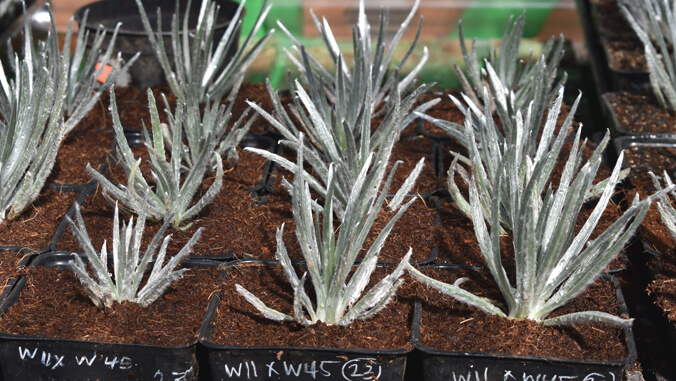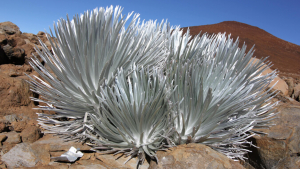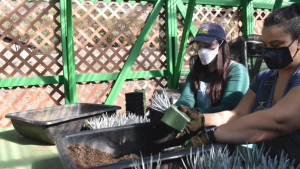
Efforts to re-establish the highly endangered silversword on Maunakea are germinating through a partnership between the University of Hawaiʻi at Hilo Center for Maunakea Stewardship (CMS) in partnership with the Hawaiʻi Department of Land and Natural Resources Division of Forestry and Wildlife (DOFAW). Silversword seeds first sown at the CMS greenhouse at the Halepōhaku mid-level facility in February 2022 sprouted into more than 100 seedlings under the care of CMS staff and are currently 3–7 inches tall. CMS staff are preparing to outplant the silversword in a fenced enclosure within the Maunakea Forest Reserve.
“I want this partnership to continue and be an example of what we can do if we work together as conservation agencies. Not only for silverswords but for all the reforestation efforts around the higher elevations of Maunakea,” said Justin Yeh, resource manager at CMS. “We want to be a hub for restoration, astronomy and education. This partnership is a step in the right direction.”
High risk of extinction

The introduction of hooved animals on Maunakea in the late 1700s severely impacted the silversword population, according to experts. In 1986, it was declared an endangered species at high risk of extinction. DOFAW launched propagation efforts in the mid-1970s that also expanded significantly in the early 1990s.
In January 2023, more than 7,000 seeds were sown at the CMS greenhouse and will continue to be nurtured by staff. The goal of CMS’ ongoing partnership with DOFAW is continuing to raise seedlings in the greenhouse and outplant them at reintroduction sites across Maunakea where previous plantings have been successful and that offer protection from hooved animals.
“There’s no words that can express how my heart feels to see this happening and to know that the silversword hopefully will be preserved for generations to come,” said Patty Heidenfeldt, a native plant restoration specialist at CMS.
Throughout the past three decades, DOFAW has reintroduced thousands of silverswords on Maunakea. According to scientists, it is important to continue to incorporate seedlings from additional wild individuals, such as the seedlings currently being grown, to help increase genetic diversity, which will give the plants a better chance to adapt to changes in their environment caused by factors such as invasive species and climate change. Increasing the number of silverswords on Maunakea can also help expand food and habitat sources for native insects such as Agrotis helela and A. kuamauna, 2 moths unique to Hawaiʻi Island.
Mālama Maunakea

CMS oversees regular monitoring of native and invasive species on Maunakea, and has been commended for its innovative efforts in native plant restoration and invasive species management. The U.S. Fish and Wildlife Service removed the native wēkiu bug from the candidate endangered species list in 2011, after CMS land stewards compiled years of research on the insect’s biology, genetics and habitat, assuring its conservation and protection. The endemic bug can only be found on puʻu (cinder cones) on the summit of Maunakea.
In 2019, CMS launched a native plant restoration project around the Visitor Information Station at the 9,000 foot elevation on Maunakea aimed at enhancing the area’s ecosystem with both common and rare native plants to help provide a habitat refuge for native birds. In 2012, CMS launched the Mālama Maunakea campaign, which connects community volunteers to help in resource management and stewardship on the mauna. As of February 2023, CMS land stewards have propagated thousands of native plants such as māmane, ʻāweoweo, ʻenaʻena, pāwale, pūkiawe, dubautia arborea (Mauna Kea Dubautia) and native grasses.
Working classroom
CMS is currently on a path to expand its conservation work on Maunakea and extend more opportunities to the community and visitors who come to the mid-level elevation to acclimate. CMS land stewards envision creating a working classroom within the mid-level elevation on Maunakea, such as providing UH student internships and field trip sites to teach Hawaiʻi’s keiki about evolution and subalpine and alpine zones.
“We want to welcome visitors, scholarly groups, researchers, conservationists, cultural practitioners to enjoy an area where it is considered restored,” said Yeh.

